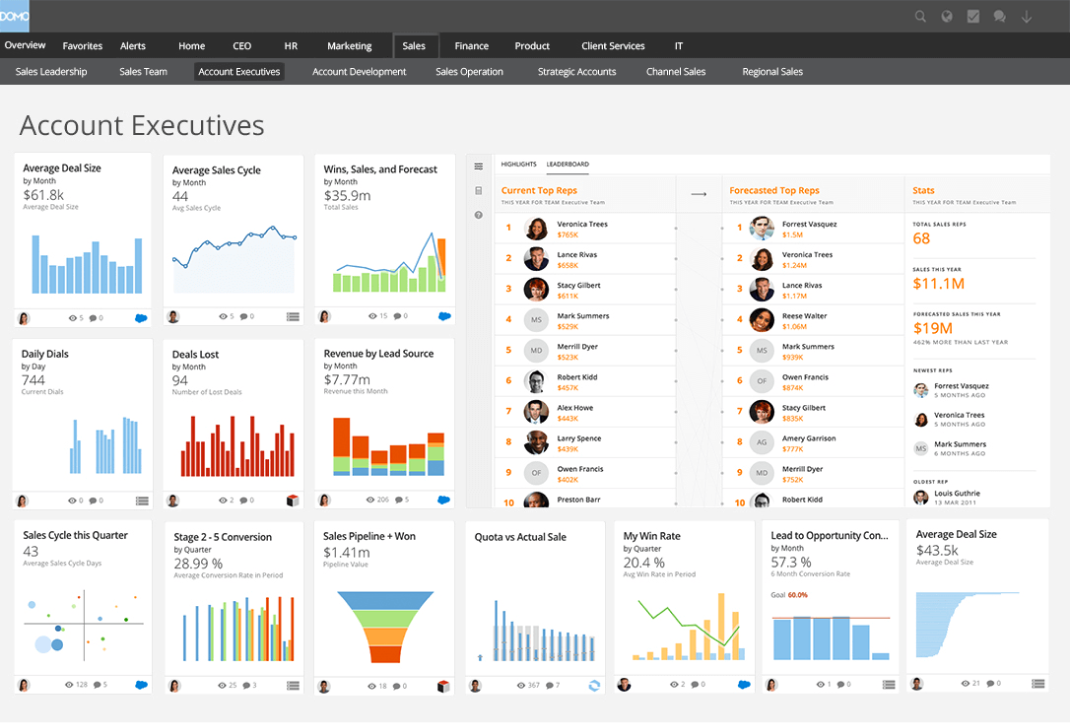How executive dashboards can help your business
Dashboards need to be tailored to their audience. While it might be nice to have a general dashboard for an entire department or project, not every stakeholder will want the same information from the dashboard.
An executive isn’t going to want the same sort of information about a topic as a low-level employee would. They might have the same general goals to move towards, but their day-to-day information needs are going to be very different.

What do executives need in a dashboard?
Executives and senior management are going to need a much more strategic view of the topic than other stakeholders might want. Since they’re the ones driving strategic change, it would make sense that they want dashboards that help them do that.
It’s best practice to build out multiple dashboards, each one prioritizing different perspectives on the data. In most projects, dashboard builders will want to start with an executive dashboard, which provides a strategic view of the entire topic.
An executive dashboard will have all the most important information that an executive or senior manager will need to make accurate, insightful strategic decisions about the topic. It should be the first place that an executive goes to get a high-level view of how their area of the business is performing.
Building executive dashboards is an important skill for those looking to boost Domo adoption within their organization. Data analysts need to recognize what sort of information executives want in a dashboard, and what elements help them recognize their strategic vision.
Executive metrics
The first step in constructing an executive dashboard is deciding which metrics to focus on. What sort of metrics do executives evaluate their own success on? This is going to vary from project to project.
In general, executive dashboards are less focused on specific metrics that might matter to frontline employees, and more focused on broad trends and department-wide statistics.
Focus on company goals
Executive dashboards are often goal-oriented. Executives set a specific goal for the organization and then monitor their executive dashboard to judge how close their department is to meeting that goal. In cases like this, it’s best to include metrics that evaluate progress towards this goal.
For example, an executive may set quotas on the sales team. Their executive dashboard would show how close the sales team is to attaining those quotas. Important metrics to highlight on this executive dashboard, then, would be things like total sales figures or the number of sales per day.
Prioritize what’s most important
In general, prioritize company or department-wide objectives and key results (OKRs) over team-specific metrics. In most cases, executives aren’t interested in the small details; they trust that the employees under them can do their job properly. They’re much more focused on general trends and broad directions.
It’s also important to present these metrics in an easy-to-understand way. For example, a data analyst could compare total sales in dollars next to the quota number, and let the executive do the math, but it would be much more useful to present total sales as a percentage of the quota. This way, it’s easier to tell how the two numbers compare.

Executive dashboard visualizations
The goal of visualizations on an executive dashboard is the same as visualizations on regular dashboards. They’re intended to make the implications of the data easier to understand.
Use simple visualizations
Many data analysts feel that they have to use the most complex and visually interesting visualizations possible on executive dashboards. To them, executive dashboards are a chance to impress their boss with their knowledge of Domo. However, that’s not always the most effective approach.
Just like with regular dashboards, the simplest approach to visualizing data is usually the most effective. Executives are busy, and they don’t have time to decode a complex visualization.
Remember your audience
On that note, executives often lack the data expertise that most data analysts have. It’s usually better to use common visualizations that can easily be understood so that executives without data training can still understand them.
It’s very important to put metrics in context when building visualizations. Data like current sales figures are useful, but it’s even more useful when evaluated besides last quarter’s sales figures and next quarter’s projections.
Put metrics in context
Visualizations like line charts and bar graphs are excellent choices for putting metrics in context. Line graphs are commonly used for comparing current data against past data. Bar graphs compare the data to other categories, like across different regions or between different sales reps.
Sometimes, data analysts can’t get away from using a complex visualization. Usually, a complex visualization will have a clear use case. If the data that needs to be graphed fits that use case, it’s better to use a complex visualization than trying to force a simpler visualization to fit.
Make sure that the visualizations you create actually tell the correct data story. For example, the scale on a line graph might over or under-represent the changes from one data point to another, depending on whether it’s too large or too small.

Holistic executive dashboard design
Ideally, a dashboard should be more than just a collection of visualizations. When putting together a dashboard, keep in mind what its central goal is. A dashboard should clearly answer a valuable business question with just a few glances.
Many executive dashboards are descriptive, meaning they’re focused on reporting things as they’re happening in that moment. This way, if anything goes wrong, the executive is the first to know.
Dashboards should instill action
Executives look to their dashboards for insight on what sort of strategic moves they should make. As such, the dashboard should recommend a clear plan of action if there’s a problem.
These plans of action might be very simple. An executive dashboard in sales might recommend senior staff to make more sales department-wide so that they can hit a quota. Other executive dashboards may have more complicated plans.
Consistent feedback and improvement
When a data analyst is ready to share their dashboard with the people who will actually be using it, they should take some time to ensure that the dashboard actually answers the questions that it needs to. It’s easy for a designer to lose sight of their goal during the design process, so it’s important to sync at the end of the process.
Dashboards are often a work in progress. A dashboard’s audience might have ideas or feedback on how to make the dashboard more effective for their position. For executive dashboards, this is especially true, since dashboard builders can rarely completely anticipate the needs of their executives.
Design is a collaborative process, and data analysts should be comfortable with making changes after the fact. The input of actual users is very valuable for constructing useful dashboards.
Conclusion
Executive dashboards give a more strategic view of a topic than regular dashboards. They’re designed to help executives and senior managers make decisions that drive company or department-wide changes.
When a data analyst makes an executive dashboard, they need to prioritize strategic data analysis. Executives are less worried about the exact details of a given analysis, and are more focused on the implications of their data.
Executive dashboards should be designed to make these data implications as easy-to understand as possible. With clear data analysis and a clear plan of action, executive dashboards can help make the way forward clear.
Check out some related resources:

Elevate Your Organization's Data-Driven Culture with Strong Governance Practices

Data-Driven Decisions Are Both Science and Art






